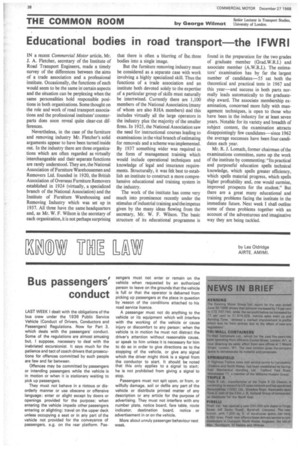Educational bodies in road transport the I FWR I
Page 40

If you've noticed an error in this article please click here to report it so we can fix it.
IN a recent Commercial Motor article, Mr. J. A. Fletcher, secretary of the Institute of Road Transport Engineers, made a timely survey of the differences between the aims of a trade association and a professional institute. Occasionally, the functions of each would seem to be the same in certain aspects and the situation can be perplexing when the same personalities hold responsible positions in both organizations. Some thought on the role and work of road transport associations and the professional institutes' counterparts does soon reveal quite clear-cut differences.
Nevertheless, in the case of the furniture and removing industry Mr. Fletcher's solid arguments appear to have been turned inside out. In the industry there are three organizations which are often regarded as virtually interchangeable and their separate functions are rarely understood. They are, the National Association of Furniture Warehousemen and Removers Ltd. founded in 1920, the British Association of Overseas Furniture Removers established in 1924 (virtually, a specialized branch of the National Association) and the Institute of Furniture Warehousing and Removing Industry which was set up in 1937. All three have the same headquarters and, as Mr. W. F. Wilson is the secretary of each organization, it is not perhaps surprising
that there is often a blurring of hie, three bodies into a single image.
But the furniture removing industry must be considered as a separate case with work involving a highly specialized skill. Thus the functions of a trade association and an institute both devoted solely to the expertise of a particular group of skills must naturally be intertwined. Currently there are 1,100 members of the National Association (many of whom are also RHA members) and this includes virtually all the large operators in the industry plus the majority of the smaller firms. In 1925, the National Association saw the need for instructional courses leading to examinations in the vital branch of estimating for removals and a scheme was implemented. By 1937 something wider was required in the form of management training which would include operational techniques and knowledge of legal and insurance requirements. Structurally, it was felt best to establish an institute to construct a more comprehensive educational and training system in the industry.
The work of the institute has come very much into prominence recently under the stimulus of industrial training and the impetus given by the many ideas flowing from the secretary, Mr. W. F. Wilson. The basic structure of its educational programme is found in the preparation for the two grades of graduate member (Grad.W.R.I.) and associate member (A.W.R.I.). The estimators' examination has by far the largest number of candidates-55 sat both the theoretical and practical tests in 1967 and this year—and success in both parts normally leads automatically to the graduateship award. The associate membership examination, concerned more fully with management techniques, is open to those who have been in the industry for at least seven years. Notable for its variety and breadth of subject content, the examination attracts disappointingly few candidates—since 1962 the average successes have been four candidates each year.
Mr. R. J. Lomath, former chairman of the examinations committee, sums up the work of the institute by commenting: "Its practical and purposeful education spells technical knowledge, which spells greater efficiency, which spells material progress, which spells higher profitability and, one would surmise, improved prospects for the student." But there are a great many educational and training problems facing the institute in the immediate future. Next week I shall outline some of these problems together with an account of the adventurous and imaginative way they are being tackled.












































































